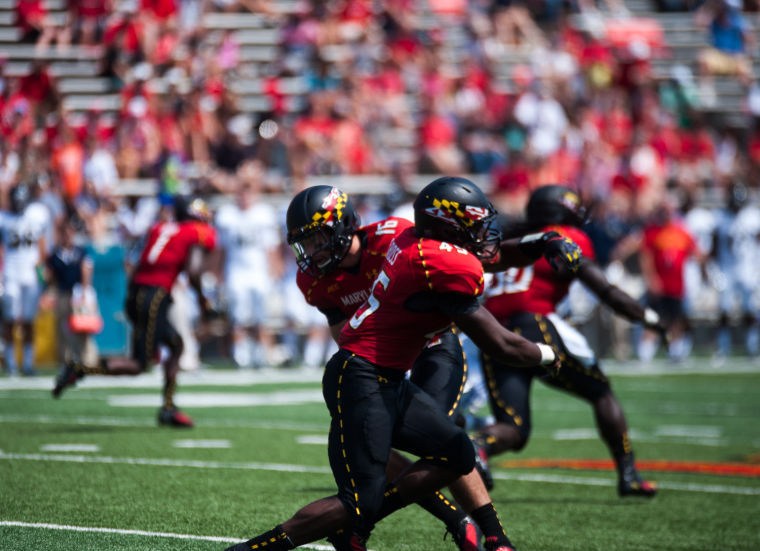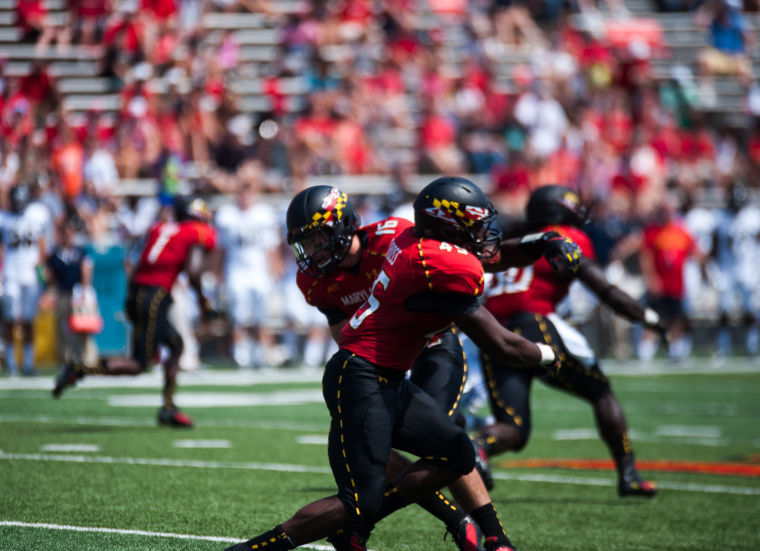When C.J. Brown takes the snap from center, the Terrapins football quarterback has only a moment to make the decision that will dictate how the next few seconds play out.
After quickly checking the opposing defensive line, he can jam the ball into running back Brandon Ross’ stomach for an inside run. He can pull it back at the last second and run to the outside, where he’ll have the chance to pitch it out to wide receiver Stefon Diggs. Or he can use all that deception to find Diggs or his fellow wide receivers Deon Long or Nigel King for a pass.
Any of those players were on display Saturday against Florida International in the Terps’ best offensive performance in nearly two years, and that’s what can be expected as the Terps continue their schedule. In offensive coordinator Mike Locksley’s second year and with the return of Brown from a torn ACL, the Terps are poised to present a dangerous offense.
“We’re a zone-read offense,” Locksley said yesterday. “So defenses have to decide who they want to stop, and if it’s Brandon, then that obviously opens up running lanes for our quarterback, which I thought C.J. took advantage of. I thought later in the game, once C.J. made a few plays, that opened things up when we subbed [running back] Albert [Reid] in there when he got some plays and was pretty productive.”
The zone-read offense has emerged as the offense of choice in college football over the past decade with its myriad looks across the nation. It’s even crossed over to the NFL, with the San Francisco 49ers riding quarterback Colin Kaepernick’s athleticism and decision-making to the Super Bowl before losing to the Baltimore Ravens.
The Terps used a similar offense in 2012, but with the athletic Brown out of the mix, it had to be tweaked to cater to the talents of backups Perry Hills and Caleb Rowe, with mixed results. The Terps finished last in the ACC in yards per game with 284.8. Their 181.8 passing yards per game were 11th, with only run-heavy Georgia Tech posting fewer, and their 103 rushing yards per game ranked 10th.
If Saturday was any indication, the offensive tide has turned for the Terps. They totaled 576 yards on offense (325 passing, 251 rushing), surpassing 500 yards of offense in a game for the first time since 2005.
“That’s what you want it to look like,” coach Randy Edsall said Tuesday.
Brown emerged as a dual-threat quarterback capable of carrying the offense Saturday after being pigeonholed as a run-first signal-caller for the early part of his career. Everyone knows he can run — he ran for 162 yards in his first start against Clemson two years ago, and he owns four of the top nine quarterback rushing performances in program history after gaining 105 yards on the ground Saturday — but there were plenty of questions about his passing.
Entering this season, he had completed 49.1 percent of his passes in his career. In his three career 100-yard rushing games before Saturday, his completion percentage was 43.6 percent.
“If I’m a defensive coach, he’s a guy that threw less than 50 percent of his passes [for] completions,” Locksley said. “I expected them to load the box up and say, ‘Hey, beat us throwing the ball.’”
And if FIU was trying to force Brown to beat them through the air, he obliged.
Brown had the best single-game completion percentage of any quarterback (minimum 20 attempts) in program history with his 20-of-23 day. He passed for 281 yards and three touchdowns.
“It feels good,” Brown said Tuesday. “I’m seeing all the things that I need to see. Just going out there and making sure you know what you’re looking at and the right reads, and going out and executing.”
It’s an added dimension for the Terps, who have proven commodities at wide receiver in Diggs, Long and King for Brown to throw to. Long had nine catches for 110 yards and a 25-yard touchdown catch, and Diggs had five catches for 98 yards, a 66-yard touchdown catch and a 26-yard run in the victory.
King was quiet, catching his only pass from Rowe in the fourth quarter for 21 yards, but the wide receivers’ roles in the zone-read offense go beyond catching passes and making plays.
“Blocking was one of my main focuses to work on throughout camp,” King said Tuesday. “I know that we have a lot of different option plays, so I know I might have to block for C.J. on the run or something like that, or I might have to block for a reverse. That’s one of my main focus points.”
Despite the offensive output, the Terps still highlighted room for improvement in the days after the win. Ross’ rushing line — 10 carries for 21 yards — could be viewed as ineffective, but it was the result of the Terps’ personnel getting deeper into the system.
“Our quarterback’s decision-making in the zone-read a few times, when you saw some of those losses that Brandon had, those were plays in which C.J. should not have given him the ball,” Locksley said. “So a lot of people kind of look at it like we didn’t really run the ball well.”
After getting back into game action, though, the Terps have more than just practice tape to go off of when picking out improvements to work on during the week. Locksley said issues from Saturday have been addressed for this weekend’s matchup with Old Dominion.
“You’ll see the biggest gains typically from Week 1 to Week 2 in a season,” Locksley said. “Still so many fundamental and technical things that we’ve got to get cleaned up.”
But the FIU victory provided a good start for the Terps. Brown’s return, Long’s addition and Diggs’ development bode well, and more results like Saturday’s could become the norm for their zone-read offense.
Said Edsall: “That’s really what you envision.”
Quarterback C.J. Brown runs the zone read with running back Brandon Ross during the Terps’ 43-10 victory over FIU on Aug. 31, 2013.
Quarterback C.J. Brown pitches the ball while in the grasp of FIU defensive end Michael Wakefield in the Terps’ 43-10 win on Aug. 31, 2013.





